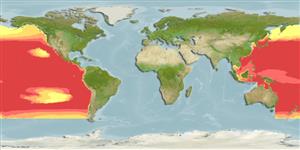Thunnus orientalis (Temminck & Schlegel, 1844)
Pacific bluefin tuna
Ajouter votre observation dans Fish Watcher
| Native range | All suitable habitat | Point map | Year 2050 |

|
| This map was computer-generated and has not yet been reviewed. |
| Thunnus orientalis AquaMaps Data sources: GBIF OBIS |
Envoyez vos Photos et vidéos
Pictures | Images GoogleThunnus orientalis
Picture by FAO
Pictures | Images GoogleThunnus orientalis
Picture by FAO
Common names from other countries
Classification / Names Noms communs | Synonymes | Catalog of Fishes(Genre, Espèce) | ITIS | CoL | WoRMS | Cloffa
> Scombriformes (Mackerels) > Scombridae (Mackerels, tunas, bonitos) > Scombrinae
Etymology: Thunnus: Greek, thynnos = tunna (Ref. 45335).
More on authors: Temminck & Schlegel.
Etymology: Thunnus: Greek, thynnos = tunna (Ref. 45335).
More on authors: Temminck & Schlegel.
Environment: milieu / climate zone / depth range / distribution range Écologie
marin; saumâtre; océanodrome (Ref. 51243); profondeur 1 - 550 m (Ref. 58302). Subtropical; 61°N - 52°S, 99°E - 70°W
Distribution Pays | Zones FAO | Écosystèmes | Occurrences | Point map | Introductions | Faunafri
North Pacific: Gulf of Alaska to southern California and Baja California and from Sakhalin Island in the southern Sea of Okhotsk south to northern Philippines. There are four substantiated records of this subspecies in the southern hemisphere: off Western Australia, southeast Pacific (37°11'S, 114°41'W) and Gulf of Papua (Ref. 10997). The species occurs mainly in the northern Pacific but ventures into New Zealand waters for at least three months during spring and early summer (Ref. 83312).
Taille / Poids / Âge
Maturity: Lm ? range ? - ? cm
Max length : 300 cm FL mâle / non sexé; (Ref. 9340); common length : 200 cm FL mâle / non sexé; (Ref. 9340); poids max. publié: 450.0 kg (Ref. 47525); âge max. reporté: 15 années (Ref. 83312)
Max length : 300 cm FL mâle / non sexé; (Ref. 9340); common length : 200 cm FL mâle / non sexé; (Ref. 9340); poids max. publié: 450.0 kg (Ref. 47525); âge max. reporté: 15 années (Ref. 83312)
Description synthétique Clés d'identification | Morphologie | Morphométrie
Mean number of gill rakers 35.9. First ventrally directed parapophysis on vertebra number 8. Dorsal wall of body cavity has a narrow bulge with lateral concavity and wide lateral trough. Caudal keels dark.
Epipelagic, usually oceanic, but seasonally coming close to shore (Ref. 168). Tolerates ample temperature intervals (Ref. 168). Forms schools by size, sometimes with other scombrids (Ref. 168). Migrates between June and September in a northward direction along the coast of Baja California, Mexico and California (Ref. 168). A voracious predator that feeds on a wide variety of small schooling fishes and squids, also on crabs crabs and to a lesser degree on sessile organisms (Ref. 168). Marketed fresh and frozen.
Life cycle and mating behavior Maturité | Reproduction | Frai | Œufs | Fécondité | Larves
Référence principale
Upload your references | Références | Coordinateur : Collette, Bruce B. | Collaborateurs
Collette, B.B., 1995. Scombridae. Atunes, bacoretas, bonitos, caballas, estorninos, melva, etc. p. 1521-1543. In W. Fischer, F. Krupp, W. Schneider, C. Sommer, K.E. Carpenter and V. Niem (eds.) Guia FAO para Identification de Especies para lo Fines de la Pesca. Pacifico Centro-Oriental. 3 Vols. FAO, Rome. (Ref. 9340)
Statut dans la liste rouge de l'IUCN (Ref. 130435: Version 2024-2)
Quasi-menacé (NT) (A2bd); Date assessed: 15 January 2021
Menace pour l'homme
Harmless
Utilisations par l'homme
Pêcheries: hautement commercial; Aquaculture: commercial; pêche sportive: oui
FAO(Aquaculture systems: production; pêcheries: production; publication : search) | FIRMS (Stock assessments) | FishSource | Sea Around Us
Plus d'informations
Trophic ecology
Éléments du régime alimentaire
Composition du régime alimentaire
Consommation alimentaire
Food rations
Prédateurs
Éléments du régime alimentaire
Composition du régime alimentaire
Consommation alimentaire
Food rations
Prédateurs
Population dynamics
Paramètres de croissance
Max. ages / sizes
Length-weight rel.
Length-length rel.
Fréquences de longueurs
Mass conversion
Recrutement
Abondance
Paramètres de croissance
Max. ages / sizes
Length-weight rel.
Length-length rel.
Fréquences de longueurs
Mass conversion
Recrutement
Abondance
Anatomy
Surface branchiale
Brain
Otolith
Surface branchiale
Brain
Otolith
Physiology
Body composition
Nutrients
Consommation d'oxygène
Type de nage
Vitesse de nage
Visual pigments
Fish sound
Diseases & Parasites
Toxicity (LC50s)
Body composition
Nutrients
Consommation d'oxygène
Type de nage
Vitesse de nage
Visual pigments
Fish sound
Diseases & Parasites
Toxicity (LC50s)
Genetics
Génétique
Heterozygosity
Héritabilité
Génétique
Heterozygosity
Héritabilité
Human related
Aquaculture systems
Profils d'aquaculture
Souches
Ciguatera cases
Stamps, coins, misc.
Aquaculture systems
Profils d'aquaculture
Souches
Ciguatera cases
Stamps, coins, misc.
Outils
E-book | Guide de terrain | Générateur de fréquences de longueur | Outil de dynamique de population | Carte par point | Classification Tree
| Catch-MSY |
Articles particuliers
Télécharger en XML
Sources Internet
Aquatic Commons | BHL | Cloffa | BOLDSystems | Websites from users | FishWatcher | CISTI | Catalog of Fishes(Genre, Espèce) | DiscoverLife | ECOTOX | Faunafri | Fishtrace | GenBank(génôme, nucléotide) | GloBI | GOBASE | | Google Books | Google Scholar | Google | IGFA World Record | MitoFish | Bases de données nationales | Otolith Atlas of Taiwan Fishes | PubMed | Reef Life Survey | Scirus | SeaLifeBase | Arbre de Vie | Wikipedia(aller à, chercher) | World Records Freshwater Fishing | Zoological Record
Estimates based on models
Preferred temperature (Ref. 115969): 13.9 - 28.1, mean 24.3 (based on 983 cells).
Phylogenetic diversity index (Ref. 82804): PD50 = 0.5039 [Uniqueness, from 0.5 = low to 2.0 = high].
Bayesian length-weight: a=0.01380 (0.00641 - 0.02973), b=3.03 (2.86 - 3.20), in cm Total Length, based on LWR estimates for this Genus-body shape (Ref. 93245).
Niveau trophique (Ref. 69278): 4.5 ±0.3 se; based on size and trophs of closest relatives
Résilience (Ref. 120179): Milieu, temps minimum de doublement de population : 1,4 à 4,4 années (tm=3-5; tmax=15; K=0.1-0.2).
Prior r = 0.25, 95% CL = 0.17 - 0.38, Based on 3 full stock assessments.
Fishing Vulnerability (Ref. 59153): Very high vulnerability (76 of 100).
Climate Vulnerability (Ref. 125649): Moderate vulnerability (38 of 100).




